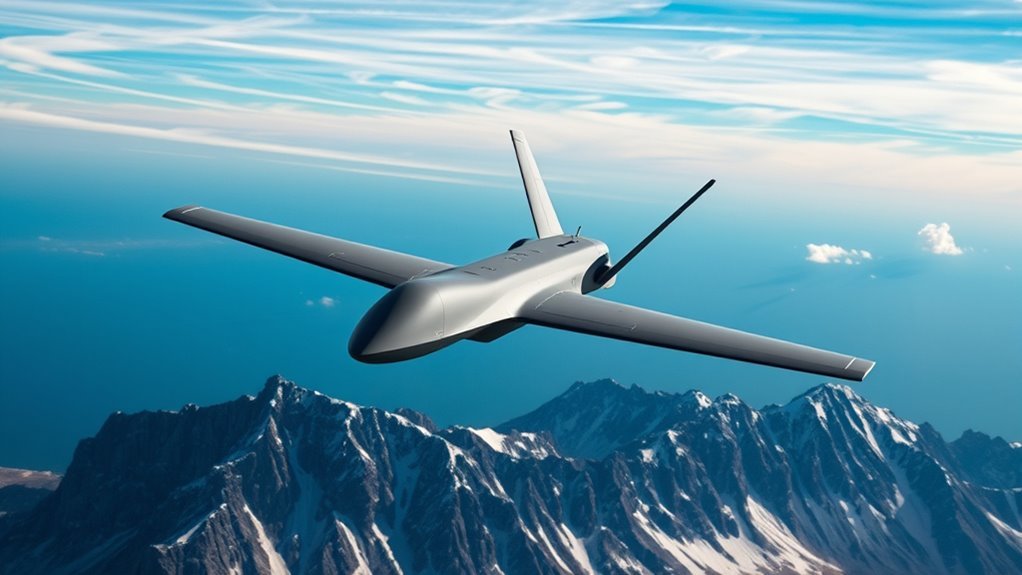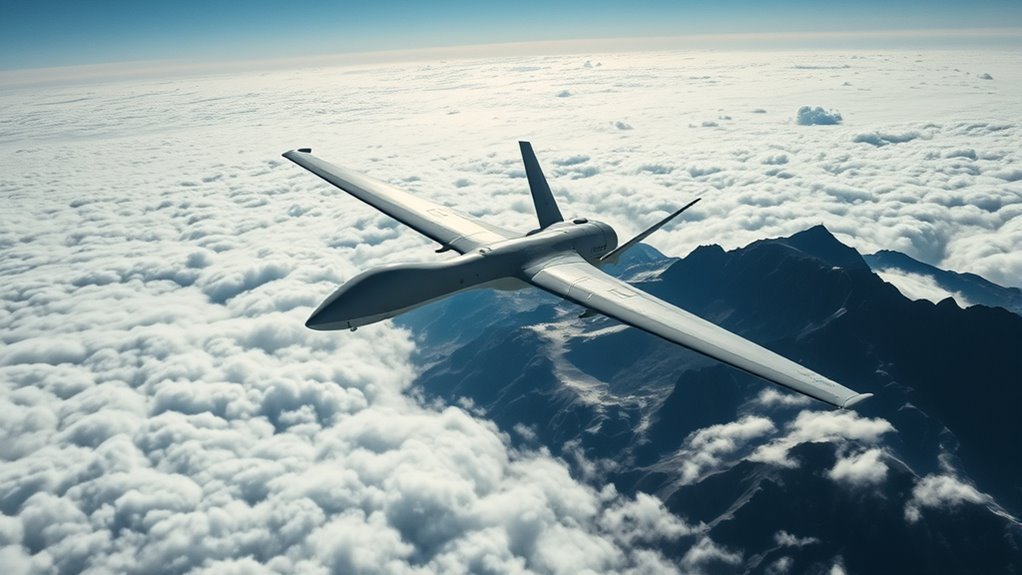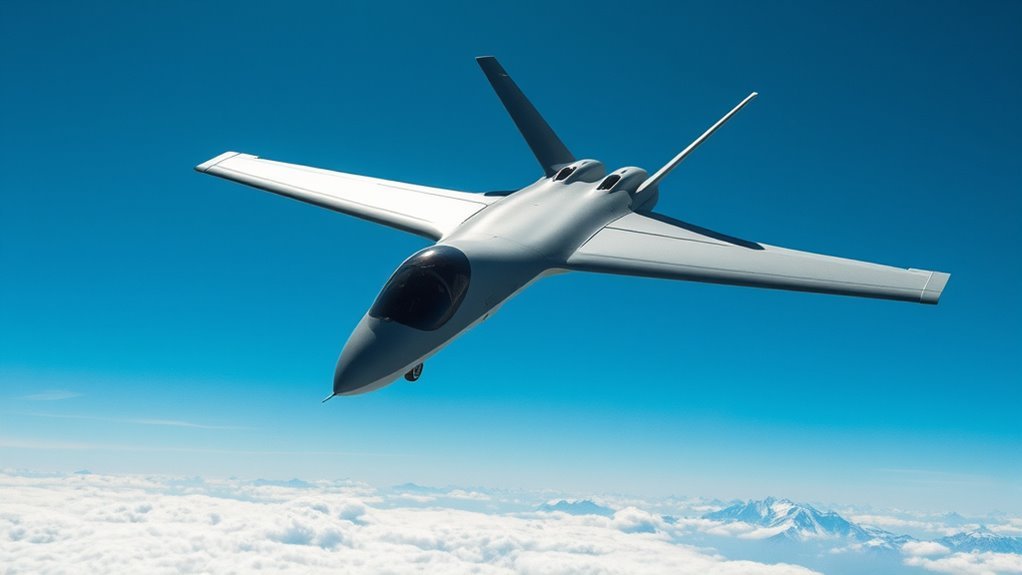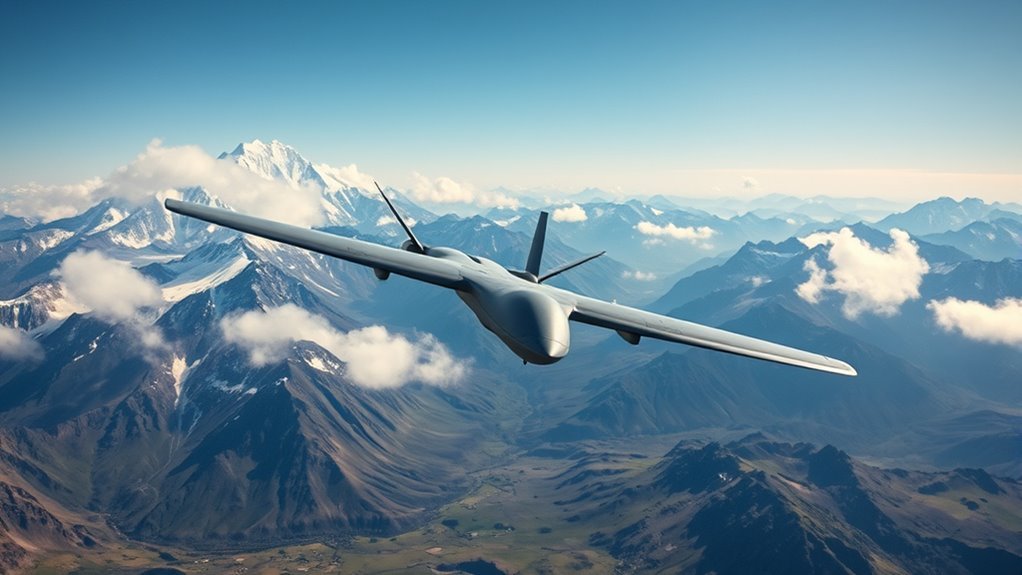Military drones can fly at altitudes exceeding 70,000 feet, showcasing advanced engineering to tackle high-altitude challenges. Their design includes optimized aerodynamics and propulsion systems that guarantee efficiency even in thinner air. The U-2 Spy Plane, for example, operates at over 70,000 feet, affording it exceptional reconnaissance capabilities while minimizing risks from ground threats. If you’re curious about how these high-altitude operations enhance military effectiveness, there are more insights waiting for you to explore.
Understanding High-Altitude Flight

Although high-altitude flight presents unique challenges, it also offers significant advantages for military drones. Understanding high altitude thermodynamics is essential for optimizing drone performance in thinner air. At elevated altitudes, the lower air density affects lift and thrust; hence, drone aerodynamics must be finely tuned to maintain stability and maneuverability. You’ll need to take into account how temperature variations and pressure changes impact engine efficiency and battery performance. Additionally, high-altitude operations enable drones to survey vast areas with reduced ground clutter, enhancing surveillance capabilities. By leveraging advanced materials and design, drones can effectively operate in these conditions, maximizing their range and operational effectiveness. Ultimately, mastering these aspects empowers military forces to achieve strategic advantages in diverse environments.
Factors Influencing Drone Altitude Capabilities

When determining a military drone’s altitude capabilities, several important factors come into play that can greatly affect performance. One primary aspect is drone design; the materials used, structure, and aerodynamic efficiency all influence how well a drone can handle thin air at higher elevations. Additionally, propulsion systems are essential—engine power and efficiency directly impact altitude performance. Altitude testing is another significant element; it validates design specs and identifies real-world limitations in various atmospheric conditions. Environmental factors, like temperature and wind patterns, also play a considerable role in altitude capability. Understanding these influences allows for better optimization of drone systems, ensuring they can operate effectively at their maximum potential, and improving operational freedom in diverse environments. Moreover, incorporating advanced technologies like AI-driven autonomy can enhance altitude performance by enabling more efficient flight paths and adaptive navigation strategies.
Comparison of Military Drone Models

Military drones vary considerably in their design, capabilities, and intended applications, making it essential to compare models to understand their strengths and limitations. For instance, consider drone endurance; some models can remain airborne for over 40 hours, allowing extensive surveillance operations. Others, however, may excel in short, tactical missions with faster deployment times. Payload capacity is another critical factor—while some drones are designed to carry heavy munitions or advanced sensors, others prioritize lightweight design for agility. Understanding these differences lets you appreciate how each model fits specific operational needs. Ultimately, the choice of drone depends on mission objectives, whether it’s prolonged surveillance, precision strikes, or rapid reconnaissance, giving you the freedom to select the right tool for the task.
Notable High-Altitude Drones in Service
When examining notable high-altitude drones, you’ll find the RQ-4 Global Hawk stands out for its impressive surveillance capabilities at altitudes exceeding 60,000 feet. The U-2 Spy Plane, with its storied history, continues to operate at similar heights, showcasing advanced reconnaissance technology. Additionally, the MQ-9 Reaper extends operational limits, balancing altitude with combat versatility.
Global Hawk Capabilities
While various high-altitude drones serve specific operational needs, the Global Hawk stands out for its exceptional capabilities. This drone offers unmatched surveillance capabilities, enabling real-time intelligence collection and reconnaissance at high altitudes. With a range of over 12,000 nautical miles and an operational ceiling of 60,000 feet, it can cover vast areas while remaining undetected.
- Persistent Surveillance: It can loiter for extended periods, providing continuous monitoring.
- Advanced Sensors: Equipped with high-resolution cameras and radar systems for detailed imagery.
- Data Integration: Seamlessly transmits gathered information to ground stations for immediate analysis.
The Global Hawk’s design allows it to operate in contested environments, making it an essential asset for modern military operations.
U-2 Spy Plane
The U-2 spy plane is a legendary high-altitude reconnaissance aircraft known for its remarkable ability to operate at altitudes exceeding 70,000 feet. Its U-2 specifications highlight a wingspan of 105 feet and a length of 63 feet, enabling exceptional lift and maneuverability. Designed for strategic intelligence gathering, the U-2 employs advanced sensors and cameras to capture high-resolution imagery, essential for national security assessments. Its operational ceiling allows it to evade many surface-to-air threats, providing invaluable reconnaissance data without the risk of interception. As you explore the capabilities of the U-2, you’ll appreciate its role in maintaining freedom through intelligence superiority. The U-2 remains an iconic symbol of aerial surveillance, adapting to evolving mission requirements over decades.
MQ-9 Reaper Limits
Although the MQ-9 Reaper is primarily known for its precision strike capabilities, it also boasts impressive altitude limits that enhance its operational effectiveness. With a maximum altitude of 50,000 feet, the MQ-9 demonstrates exceptional performance, allowing it to conduct surveillance and reconnaissance missions well above standard air traffic. This altitude capability greatly expands its operational range and versatility.
- MQ-9 capabilities include long-endurance flights, providing persistent surveillance.
- The drone integrates advanced sensors for real-time intelligence gathering.
- Its high-altitude performance allows for safer operations in contested environments.
These features make the MQ-9 a crucial asset in modern warfare, offering tactical advantages that empower freedom of action on the battlefield.
Technical Specifications and Performance
Military drones exhibit a range of technical specifications that greatly impact their performance capabilities. Key aspects include drone design, which dictates structural integrity, weight distribution, and aerodynamics. For instance, lightweight materials enhance altitude performance, allowing drones to reach higher elevations efficiently.
Altitude sensors are essential, providing real-time data that enables precise altitude adjustments during flight. This technology helps maintain optimal performance and stability, especially at extreme altitudes.
Moreover, the propulsion system plays a vital role in overcoming atmospheric resistance at high elevations. Understanding these specifications guarantees that you appreciate the complex engineering that allows military drones to operate effectively in challenging environments. Overall, these elements work cohesively to enhance operational effectiveness while maximizing altitude performance.
Strategic Advantages of High-Altitude Operations
High-altitude operations offer strategic advantages that can greatly enhance mission effectiveness. By flying at elevated altitudes, military drones can achieve significant improvements in surveillance efficiency and reconnaissance benefits. This altitude allows them to cover vast areas while remaining out of reach of many ground-based threats.
- Enhanced visibility: High-altitude drones can observe large territories with fewer obstructions, ensuring clear data collection.
- Reduced risk: Operating at altitude minimizes exposure to enemy fire, keeping valuable assets safer.
- Improved data accuracy: Higher vantage points lead to better resolution in imagery, resulting in more precise intelligence.
These advantages make high-altitude operations an essential component of modern military strategy, ensuring you have the information needed for effective decision-making while maintaining operational security.
Challenges of Operating at High Altitudes
Operating at high altitudes presents significant challenges that affect drone performance and reliability. You’ll encounter issues like reduced atmospheric pressure, which impacts engine efficiency and overall thrust. Additionally, navigation and control systems may struggle to maintain stability in these conditions, complicating mission execution.
Atmospheric Pressure Effects
As drones ascend to greater altitudes, they encounter significant challenges due to the decreased atmospheric pressure. This pressure variation directly affects the atmospheric density, which can impact various systems within the drone. You need to understand these challenges to guarantee ideal performance and mission success.
- Reduced lift generation can hinder maneuverability.
- Limited oxygen availability can affect electronic systems and sensors.
- Increased susceptibility to environmental factors like turbulence.
Navigating these issues requires advanced engineering solutions and operational strategies. By addressing the effects of atmospheric pressure, you can enhance the capability of military drones, enabling them to operate effectively in the thin air of high altitudes, thereby achieving greater freedom in aerial missions.
Engine Performance Limitations
While many military drones are designed for versatility, their engine performance often suffers at elevated altitudes. As altitude increases, the thinner air reduces oxygen availability, directly impacting engine efficiency. This phenomenon results in diminished thrust and power output, making it challenging to maintain ideal flight conditions. To achieve effective altitude enhancement, engineers must balance design parameters, such as fuel type and engine configuration, to mitigate these performance limitations. Advanced materials and technologies can enhance engine resilience, but they also introduce complexity and cost. Ultimately, understanding and addressing these engine performance challenges is essential for maximizing the operational capabilities of high-altitude military drones, allowing them to fulfill their missions while maneuvering the constraints imposed by high-altitude environments.
Navigation and Control Issues
Maneuvering and controlling military drones at high altitudes presents unique challenges that can greatly affect mission success. The thinner atmosphere and increased distance from ground control can lead to various navigation and control issues, including:
- Sensor Accuracy: High altitudes may reduce the effectiveness of onboard sensors, impacting data reliability.
- Signal Interference: Atmospheric conditions can disrupt communication links, making real-time adjustments difficult.
- Autonomous Navigation: Limited GPS availability at extreme altitudes can hinder autonomous operations, requiring more manual intervention.
These factors necessitate advanced technology and strategic planning to guarantee that drones operate effectively in high-altitude environments. Understanding these challenges is essential for maintaining operational readiness and achieving mission objectives.
Future Trends in High-Altitude Drone Technology
Emerging advancements in high-altitude drone technology are set to redefine military operations, particularly in surveillance and reconnaissance. As you explore these developments, you’ll notice a significant shift towards autonomous systems, enhancing operational efficiency and reducing human risk. These drones are being engineered to operate at unprecedented altitudes, leveraging energy efficiency to extend their flight duration and coverage. Innovations in materials and propulsion systems are essential, allowing for lighter designs that can withstand extreme conditions. Furthermore, integrating artificial intelligence will enable real-time data analysis, improving decision-making on the battlefield. As these trends unfold, you’ll see military strategies evolve, empowering forces to maintain oversight and control in challenging environments, ultimately supporting the quest for freedom and security. Additionally, autonomous software systems will play a crucial role in optimizing flight paths for enhanced operational effectiveness. The incorporation of AI-driven algorithms will further enhance the adaptability and precision of these high-altitude drones in tactical scenarios.
Frequently Asked Questions
What Altitude Limits Do Civilian Drones Typically Have Compared to Military Drones?
Civilian drones typically operate below 400 feet, while military drones can reach considerably higher altitudes. This difference highlights civilian capabilities versus military advantages, allowing armed forces to conduct operations beyond the reach of standard civilian technology.
How Do Weather Conditions Affect High-Altitude Drone Operations?
Imagine flying a kite in a storm; weather patterns greatly impact high-altitude drone operations. Changes in atmospheric pressure can affect stability, control, and performance, making it essential to analyze conditions before deployment in such environments.
What Are the Legal Regulations Concerning High-Altitude Drone Flights?
When considering high-altitude drone flights, you must guarantee regulatory compliance and secure flight authorization. Understanding airspace classifications, restrictions, and international treaties is essential for maintaining operational freedom while adhering to legal frameworks governing aerial operations.
Can High-Altitude Drones Be Used for Commercial Purposes?
Using high-altitude drones is like revealing a treasure chest of possibilities. Their commercial applications offer significant benefits, including surveillance, mapping, and data collection, enhancing various industries while providing operational efficiency and cost savings for businesses.
What Are the Safety Measures for High-Altitude Drone Missions?
For high-altitude drone missions, you need robust safety measures. Implement emergency protocols, and guarantee team members undergo altitude training. These practices minimize risks, enhancing operational efficiency and maintaining compliance with safety regulations during missions.

